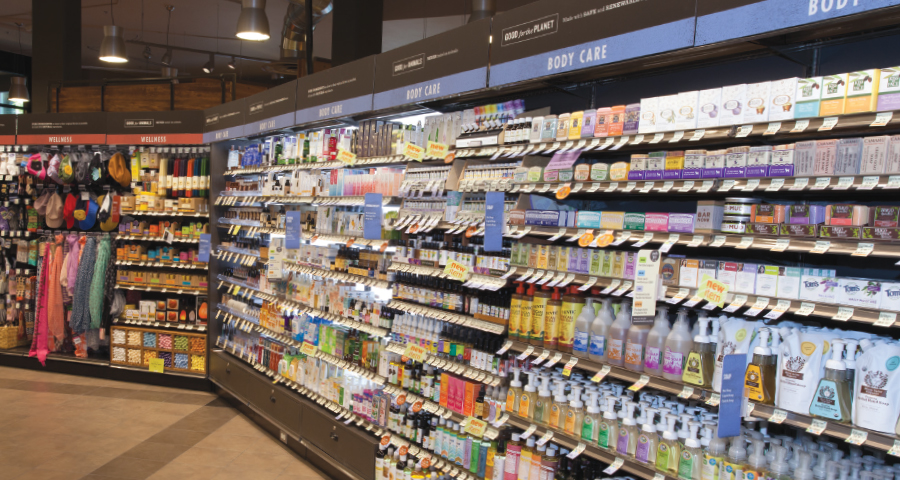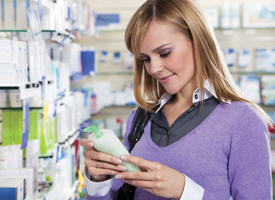New standards for PCC Health & Body Care
by Marilyn Walls, M.S.
This article was originally published in May 2016

When it comes to setting standards for PCC products, the most complicated ingredients may be in supplements and body care products. The shelves of the health and body care department (HBC) include vitamins, toothpastes, probiotics and body lotions — an array of products that can be a dream come true, or a nightmare, depending on where you shop!
Customers often express appreciation that products at PCC are vetted to adhere to PCC’s high standards and values. While this does not mean customers should forego reading labels or asking questions of suppliers, customers can rest assured that each product is being put through a rigorous process where everything from the smallest ingredient to the larger environmental impact is considered.
Like other departments at PCC Natural Markets, HBC gives preference to organic, non-GMO and local products. Products tested on animals have not been allowed in HBC for years.
While many PCC quality standards for foods could apply to HBC products, analysis of the complex HBC world requires separate standards. Recognizing this, PCC took the first step four years ago by eliminating body care products with parabens and other irritants. Recently, PCC established a subcommittee to create criteria for evaluating ingredients in every HBC supplement and body care product.
Our evaluation criteria for ingredient decisions are similar to those for other PCC standards. Safety, efficacy and low environmental impact are primary. We also seek renewable ingredients that aren’t synthetic. Each criteria is considered before an ingredient is allowed in an HBC product at PCC.
Safety
Supplements are regulated for safety and the integrity of their claims by the government through DSHEA (Dietary Supplement Health and Education Act of 1994), but body care products are unregulated. Body care product labeling has been compared to the Wild West.
That put the onus on PCC to examine research about the effects of ingredients on personal health, allergies and other health risk factors — from skin irritants to carcinogens.
Efficacy
Simply put, the product must work. The ingredients must be necessary for the functioning or appeal of the product.
Our buyers look for products that are tested for efficacy and verified with clinical trials.
Not synthetic
This is perhaps the most difficult measure. We use the U.S. Food and Drug Administration (FDA) definition of synthetic: It considers the source and the chemical process of making the ingredient.
Nothing petroleum-based is allowed and ingredients must come from a renewable resource found in nature. We also review whether there’s a nonsynthetic or alternative substance available to replace synthetic ingredients.
Customers often refer to Environmental Working Group (EWG) research and ratings as a helpful standard for deciding on body care products. While PCC admires and supports the work of EWG, we raised the bar. Ingredients rated #1 by EWG may be synthetic. PCC prohibits synthetic ingredients in HBC products whenever possible.
Environmental impact
The ingredients we allow have the least adverse effects on the environment during manufacture, use or disposal.
Ingredients cannot compromise the health of the workers involved in any stage of the process.
The prohibited list
With these above criteria as a guide, we established a Prohibited Ingredient List for all supplement and body care products. More than 500 ingredients common in mainstream and some “natural” products are not allowed in HBC products at PCC Natural Markets.
We believe PCC has the highest HBC standards of any retailer. Other retailers identify “top-tier” products meeting similar standards, yet still sell other products with ingredients not meeting those standards.
The toothpaste example
For a look at the intricacies of implementing the new HBC standards, toothpaste is a good place to start. Toothpaste selection is a visible result of changing HBC standards, which is to say your favorite toothpaste may not be sold at PCC any longer. SLS is the ingredient that led us to drop some very popular products.
According to the independent Cosmetic Ingredient Review (CIR), “SLS” often is used incorrectly as an umbrella abbreviation to cover a variety of chemicals, including sodium lauryl sulfate, sodium laureth sulfate, ammonium lauryl sulfate, sodium lauroyl sarconsinate, and similar surfactants used in personal care products. Those names would be listed on the label rather than SLS.
They are inexpensive foaming detergents, used in car washes and engine degreasers, as well as toothpastes, shampoos, shower gels and other cleansers. Even the CIR, which deemed sodium lauryl sulfate safe, acknowledged it may induce eye and skin irritation.
Of bigger concern is the possibility that sodium laureth sulfate, according to EWG, “may be contaminated with potentially toxic manufacturing impurities, such as 1,4-dioxane. 1,4-dioxane is an unwanted byproduct of an ingredient processing method called ethoxylation.” Ethoxylation is a chemical reaction employing some nasty elements to create foam and stabilize mixtures. It’s not for the ingredient purist!
Neither the sources of ingredients, nor the process of ethoxylation, meets PCC’s criteria for safety, environmental impact or non-synthetic/renewable. The Environmental Protection Agency classifies dioxane as a probable human carcinogen. The FDA suggested (but did not require) that manufacturers remove 1,4-dioxane from personal care products. In addition to being synthetic and possibly toxic to humans, the ethoxylation process also may be damaging to aquatic life.
A customer would not ever see 1,4-dioxane listed as an ingredient — one signal of the depth we must dig to understand ingredients and put the new HBC standards in place. Since PCC chooses to be precautionary, erring on the side of protecting customers at all times, SLS did not meet the first criteria — safety. We know alternative ingredients are readily available to replace SLS. So, all toothpaste products containing SLS have been discontinued.
Ingredients to “sunset”
Ethoxylation and 1,4-dioxane contamination extend beyond toothpaste and cleansers. EWG rates 1,4-dioxane as a high hazard overall and as a risk in polysorbates and ingredients with PEG (polyethylene glycol) in the name. This affects other products carried in HBC, such as lotions, mouthwashes and face creams.
Such ingredients are used to emulsify the product into a smooth mixture, to blend elements and prevent separation. PCC will “sunset” products containing polysorbates, PEG, SLS and others that are ethoxylated, or pose risks of dioxane contamination. It means no new products containing these ingredients will be accepted at PCC, and current vendors will be given 18 months to reformulate.
Thankfully, there are nonsynthetic versions available now, and PCC will require documentation from our vendors that the source and process are not synthetic. That may be inconvenient for manufacturers and some customers at first, but making these changes will protect the health of humans and sea life.
The safer standard for toothpaste is but one example of what has been considered in creating PCC’s new HBC Prohibited List. The subcommittee has given thanks for brain-supporting supplements and relaxing herbals to face the strenuous task of understanding scientific names and processes, and to balance that information with what customers like to buy!
As in life, there are exceptions to the rules. Hair color is the biggest exception.
Some ingredients on the Prohibited List can be found in hair coloring products, including PEGs. Those ingredients are needed currently for hair coloring to work and we believe our hair coloring products use the most natural ingredients available. We will continue to seek new hair color products closer to our standards. Meanwhile, no hair colors will be eliminated due to ingredients.
The Prohibited List likely will evolve for continual improvement, a living entity shaped by innovations in the natural products industry and emerging research about ingredients. An immense amount of work will be required to bring HBC in line with the new Prohibited List, from communication with companies’ scientists to explanations for customers.
PCC’s mission, however, to be transparent and trustworthy for customers, is well served by these changes.

Prohibited ingredients
Surfactants: SLS, MEA, DEA and ETA
- Function: Increase foam.
- Alternative: Learn to embrace less or no-foam in toothpastes and shampoos or add more water.
Ceteth-20 phosphate (emulsifier)
- Function: Disperse liquids and meld elements.
- Alternative: Shake container to mix ingredients!
Propionates (preservative)
- Function: Antibacterials to increase shelf life.
- Alternative: Use products regularly. Keep in a cool, dry place.
Mineral oil (emollients)
- Function: Condition and soften skin and hair.
- Alternative: Look for non-synthetic oils that aren’t chemically extracted.
Polyethylene glycol (detergent)
- Function: Cleansing.
- Alternative: Choose gentler options for clean body and hair.
Synthetic perfumes
- Function: Fragrance.
- Alternative: Choose essential oils or food-derived scents.
